Toronto Pearson International Airport
| Toronto Pearson International Airport Aéroport international Pearson de Toronto | |||||||||||||||||||||||||||
|---|---|---|---|---|---|---|---|---|---|---|---|---|---|---|---|---|---|---|---|---|---|---|---|---|---|---|---|
 | |||||||||||||||||||||||||||
 | |||||||||||||||||||||||||||
| Summary | |||||||||||||||||||||||||||
| Airport type | Public | ||||||||||||||||||||||||||
| Owner | Transport Canada | ||||||||||||||||||||||||||
| Operator | Greater Toronto Airports Authority (GTAA) | ||||||||||||||||||||||||||
| Serves | Greater Toronto | ||||||||||||||||||||||||||
| Location | Mississauga and Toronto, Ontario, Canada | ||||||||||||||||||||||||||
| Hub for | |||||||||||||||||||||||||||
| Focus city for | |||||||||||||||||||||||||||
| Time zone | EST (UTC−05:00) | ||||||||||||||||||||||||||
| • Summer (DST) | EDT (UTC−04:00) | ||||||||||||||||||||||||||
| Elevation AMSL | 569 ft / 173 m | ||||||||||||||||||||||||||
| Coordinates | 43°40′36″N 079°37′50″W / 43.67667°N 79.63056°WCoordinates: 43°40′36″N 079°37′50″W / 43.67667°N 79.63056°W | ||||||||||||||||||||||||||
| Website |
www | ||||||||||||||||||||||||||
| Map | |||||||||||||||||||||||||||
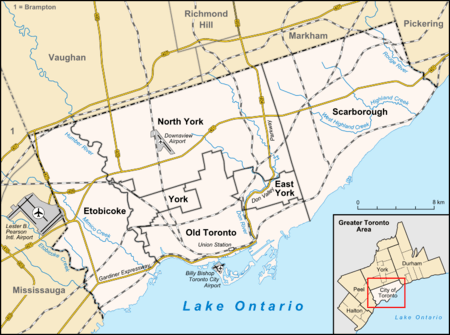 YYZ Location within Toronto  YYZ YYZ (Ontario)  YYZ YYZ (Canada) 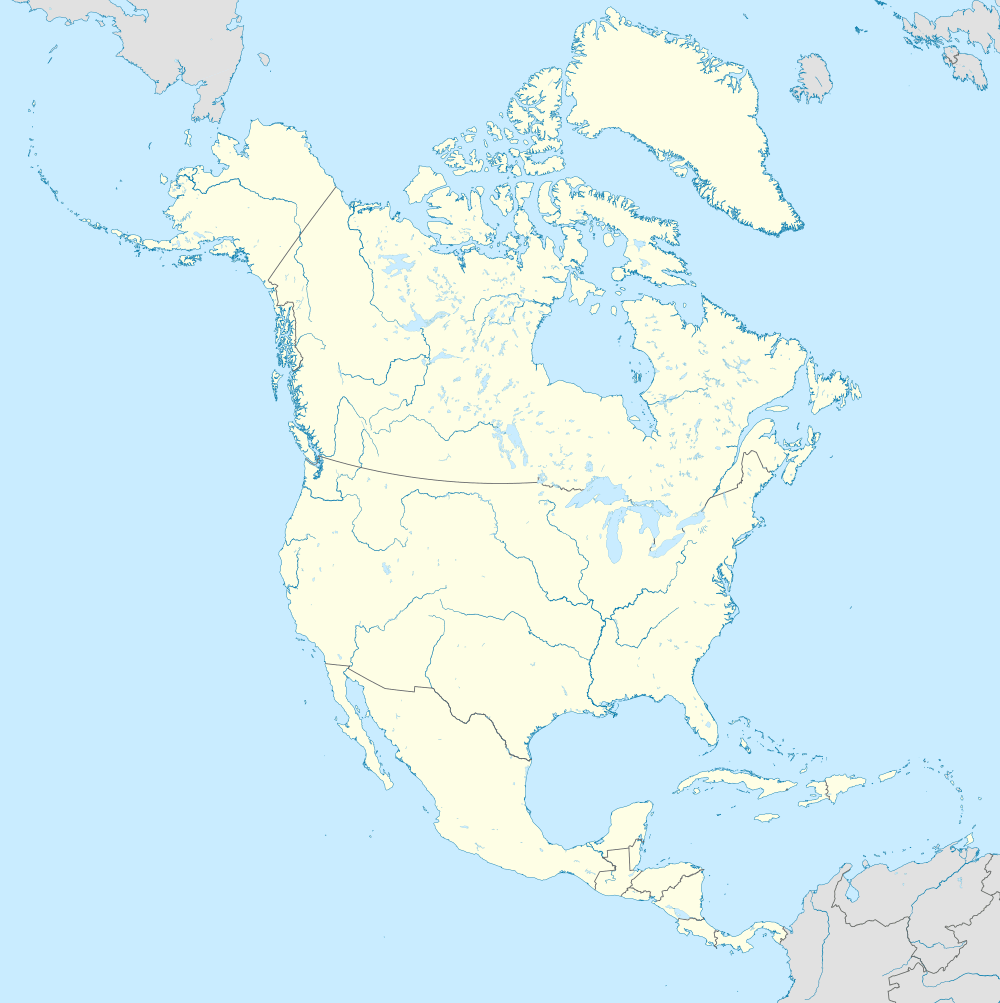 YYZ YYZ (North America) | |||||||||||||||||||||||||||
| Runways | |||||||||||||||||||||||||||
| |||||||||||||||||||||||||||
| Statistics (2017) | |||||||||||||||||||||||||||
| |||||||||||||||||||||||||||
|
Sources: Canada Flight Supplement[1] Environment Canada[2] Transport Canada[3] Movements from GTAA[4] Toronto Pearson Traffic Summary[5] | |||||||||||||||||||||||||||
Toronto Pearson International Airport (IATA: YYZ, ICAO: CYYZ) (often referred to as Toronto Pearson, Pearson Airport, or simply Pearson) is the primary international airport serving Toronto, its metropolitan area, and surrounding region known as the Golden Horseshoe in the province of Ontario, Canada. It is the largest and busiest airport in Canada,[6] the second-busiest international air passenger gateway in the Americas,[7] and the 30th-busiest airport in the world by passenger traffic, handling 47.1 million passengers in 2017.[8] The airport is named in honour of Lester B. Pearson, Nobel Peace Prize laureate and 14th Prime Minister of Canada.
Toronto Pearson is located 22.5 kilometres (14.0 mi) northwest of Downtown Toronto, with the majority of the airport situated in the adjacent city of Mississauga, and a small portion of the airfield extending into Toronto's western district of Etobicoke.[9] It features five runways and two passenger terminals along with numerous cargo and maintenance facilities on a site that covers 18.67 square kilometres (7.2 sq mi).[10]
Pearson Airport is the main hub for Air Canada.[11] It also serves as a hub for WestJet and cargo airline FedEx Express, and as a base of operations for Air Transat and Sunwing Airlines. Pearson is operated by the Greater Toronto Airports Authority (GTAA) as part of Transport Canada's National Airports System,[12] and is one of eight airports in Canada with United States border preclearance.[13]
An extensive network of non-stop domestic flights is operated from Pearson by several airlines to all major and many secondary cities across all provinces of Canada.[14] As of 2018, over 75 airlines operate around 1,250 daily departures from Toronto Pearson to more than 180 destinations across all six of the world's inhabited continents.[15][16][17]
History
In 1937, the Government of Canada agreed to support the building of two airports in the Toronto area. One site selected was on the Toronto Islands in Downtown Toronto, which is the present-day Billy Bishop Toronto City Airport. The other site selected was an area northwest of Toronto near the town of Malton, which was originally intended to serve as an alternate to the downtown airport but instead would become its successor.[18] The first scheduled passenger flight at the Malton Airport was a Trans-Canada Air Lines DC-3 that landed on August 29, 1939.[19]
In 1958, the City of Toronto sold the Malton Airport to Transport Canada, who subsequently changed the name of the facility to Toronto International Airport.[20] The airport was officially renamed Lester B. Pearson International Airport in 1984, in honour of Lester B. Pearson, the fourteenth Prime Minister of Canada and recipient of the 1957 Nobel Peace Prize. The Greater Toronto Airports Authority (GTAA) assumed management, operation, and control of the airport in 1996, and has used the name Toronto Pearson International Airport for the facility since their acquisition.[21]
Terminals
Toronto Pearson International Airport has two active public terminals, Terminal 1 and Terminal 3. Both terminals are designed to handle all three sectors of travel (domestic, transborder, and international), which results in terminal operations at Pearson being grouped for airlines and airline alliances, rather than for domestic and international routes.
A third public terminal, the Infield Terminal (IFT), currently acts as an extension of Terminal 3 providing additional bridged gates.
Terminal 1
.jpg)
Measuring over 346,000 square metres (3,724,000 sq ft),[22] Terminal 1 is the largest terminal at Pearson Airport and is among the largest buildings in the world by floor space. Air Canada, other Star Alliance airlines that connect to Pearson, and Emirates are based at Terminal 1.
Terminal 1 was designed by a joint venture known as Airports Architects Canada made up of Skidmore, Owings & Merrill LLP, Adamson Associates Architects and Moshe Safdie and Associates.[23] It contains 58 gates: D1, D3, D5, D7-D12, D20, D22, D24, D26, D28, D31–D45 (D32, D34, D36 also serve US flights and carry F designation), D51, D53, D55, D57 (also carry F designation), F60–F63, F64A–F64B, F65, F66A–F66B, F/E67–F/E81 (F68-F73 and F78-F81 serve both US and international flights but E74-E77 are international only), F91, and F93. Two of the gates, E73 and E75, can accommodate the Airbus A380.
Along with the standard customs and immigration facilities, Terminal 1 also contains special customs "B" checkpoints along the international arrivals walkway. Passengers connecting from an international or trans-border arrival to another international (non-U.S.) departure in Terminal 1 go to one of these checkpoints for passport control and immigration checks, then are immediately directed to Pier F for departure. This alleviates the need to recheck bags, pass through security screening, and relieves congestion in the primary customs hall.[24]
An 8-level parking garage with 8,400 public parking spaces (including 700 rental car spaces) [22] across from Terminal 1 is connected to the terminal by several elevated and enclosed pedestrian walkways.[20]
Terminal 1 is home to the ThyssenKrupp Express Walkway, the world's fastest moving walkway.[25]
Terminal 3
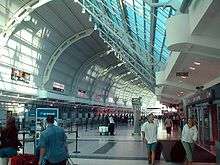
Terminal 3 is a 178,000-square-metre (1,916,000 sq ft) facility designed by B+H Architects and Scott Associates Architects Inc.[26] It is used by all SkyTeam and Oneworld airlines that serve Pearson, along with Air Transat, Etihad Airways, Sunwing Airlines, WestJet and all other airlines that are unaffiliated with an airline alliance (except Emirates, which uses Terminal 1). Terminal 3 has 48 gates: A1–A6, B1a-B1d, B2a-B2b, B3-B5, B7–B20, B22 and C24–C41.
A 5-level parking garage with 3,800 public parking spaces (including 600 rental car spaces) [22] is located directly across from the terminal along with the Sheraton Hotel, both of which are connected to Terminal 3 by an elevated pedestrian walkway.[20][27]
Since June 2018, the GTAA has utilized the Infield Terminal to act as an extension of Terminal 3 to provide additional bridged gates. Passengers on flights arriving or departing from gates at the Infield Terminal are transported by bus to/from Terminal 3.[28]
Infield Terminal
The Infield Terminal was originally built to handle traffic displaced during the development and construction of the current Terminal 1.[29] Its 11 gates (521 to 531) were opened gradually throughout 2002 and 2003,[30] and a business lounge was opened in 2005.[31][30] In 2009, the Infield Terminal (also known as the IFT) was closed for regular operations in conjunction with the official opening of the newly constructed Terminal 1. However the GTAA retained plans to reactivate the IFT for regular operations whenever necessary to accommodate seasonal or overflow demand.
Renovations were completed at the Infield Terminal in early 2018, and on June 5, 2018, the terminal was reactivated for summer operations by the GTAA to act as an extension of Terminal 3 with the purpose of providing required additional bridged gates. Passengers are transported by bus between Terminal 3 and the Infield Terminal.[28]
The IFT is also frequently used as a location to film major motion pictures and television productions.[32]
VIP Terminal
Skyservice FBO operates an 800-square-metre (8,611 sq ft) private VIP terminal at Toronto Pearson on Midfield Road, in the infield area of the airport.[33][34] The terminal handles most private aircraft arriving and departing at Pearson, providing passenger services that include 24/7 concierge, private customs and immigration facilities, personalized catering, showers, direct handling of baggage, and VIP ground transportation services.[33][35]
Infrastructure and operations
Runways
Toronto Pearson has five runways, three of which are aligned in the east-west direction, and two in the north-south direction. A large network of taxiways, collectively measuring over 40 km (25 mi) in length,[36] provides access between the runways and the passenger terminals, air cargo areas, and airline hangar areas.[37]
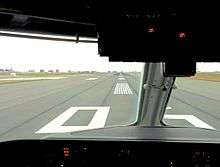
| Number | Length | Width | ILS | Alignment |
|---|---|---|---|---|
| 05/23 | 3,389.4 metres (11,120 ft) | 61 metres (200 ft) | Cat. IIIa (05), Cat. I (23) | East-West |
| 06L/24R | 2,955.6 metres (9,697 ft) | 61 metres (200 ft) | Cat. IIIa (6L), Cat. I (24R) | East-West |
| 06R/24L | 2,743.2 metres (9,000 ft) | 61 metres (200 ft) | Cat. I (both directions) | East-West |
| 15L/33R | 3,368 metres (11,050 ft) | 61 metres (200 ft) | Cat. I (both directions) | North-South |
| 15R/33L | 2,770 metres (9,088 ft) | 61 metres (200 ft) | Cat. I (both directions) | North-South |
Airfield operations
Pearson is home to Toronto Area Control Centre, one of seven Air Control Centers in Canada, all of which are operated by Nav Canada. The airport's main control tower is located within the infield operations area. Pearson is one of two airports in Canada with a Traffic Management Unit (TMU) to control planes on the apron areas.[38] The TMU is located in the tower at Terminal 1.
.jpg)
The Greater Toronto Airports Authority (GTAA) Fire and Emergency Service maintains 3 fire stations on the airport property, with a team of more than 80 firefighters that provide fire and rescue operations at Pearson. The fire service is equipped with 6 crash tenders as well as several pumpers, aerial ladders, and heavy rescue units.[39]
The airport's 115-member airfield maintenance unit is responsible for general maintenance and repairs at the airport.[9] From mid-November to mid-April, the unit is in winter mode armed with a $38 million snow removal budget.[40] The airport employs over 94 pieces of snow clearance equipment, including 11 Vammas PSB series[40] and 4 Oshkosh HT-Series[41] snowplow units, and 14 snow melters.[42]
Pearson Airport's Central De-icing Facility is the largest in the world, servicing about 10,500 aircraft each winter.[42] The six de-icing bays can handle up to 12 aircraft at a time and take between 2 and 19 minutes per aircraft.[43]
Cargo facilities
Toronto Pearson handles over 50% of total international air cargo in Canada.[44] The airport has three main cargo facilities, known as Cargo West (Infield), Cargo East (VISTA), and Cargo North (FedEx).[45]
The Cargo West facility (also known as the Infield Cargo Area) is located between runways 15L/33R and 15R/33L. It is a multi-tenant facility including three large buildings with 52,600 square metres (566,000 sq ft) of warehouse space, a common use cargo apron, vehicle parking, and a truck maneuvering area. A four-lane vehicle tunnel connects the Infield Cargo Area to the passenger terminal area of the airport.[46]
The Cargo East facility (also known as the VISTA cargo area) is located north of Terminal 3. The VISTA cargo area is a multi-tenant facility of several buildings organized in a U-shape, with 29,500 square metres (318,000 sq ft) of warehouse space and an adjacent common use cargo apron.[46]
The Cargo North facility is the Canadian hub for FedEx Express. The site occupies an area on the north side of the airport lands near runway 05/23, and is home to two buildings operated exclusively by FedEx with 32,100 square metres (346,000 sq ft) of warehouse space and a dedicated cargo apron.[46]
Other facilities
Pearson Airport has seven aircraft maintenance hangars, operated by Air Canada, Air Transat, Westjet, and the GTAA, which are used for line maintenance and routine aircraft inspections.[46] The airfield's north end has numerous hangars for personal private jets and charter aircraft, along with passenger facilities and maintenance services for them.[47]
The Greater Toronto Airports Authority maintains offices at 3111 Convair Drive, near the southeast corner of the airport. Gate Gourmet and CLS Catering Services both operate dedicated flight kitchen facilities at Pearson for airline catering services.[46] Aviation fuel (Jet A-1) is supplied by Esso Avitat and Shell Aerocentre, both located in the airport's infield area.[46]
Security
The Peel Regional Police is the primary law enforcement agency at Toronto Pearson.[48] The Royal Canadian Mounted Police (RCMP) also maintain a Toronto Airport Detachment at Pearson which provides federal law enforcement services.[49]
The Canadian Air Transport Security Authority (CATSA) is responsible for security screening procedures at Pearson Airport. Other government agencies with security operations at Pearson include the Canada Border Services Agency (CBSA), Immigration, Refugees and Citizenship Canada (IRCC), and Transport Canada. In addition, U.S. Customs and Border Protection (CBP) and United States Citizenship and Immigration Services (CIS) also conduct operations at the airport to facilitate United States border preclearance.[50]
Airlines and destinations
Passenger
Cargo
| Airlines | Destinations | Cargo Center |
|---|---|---|
| Cathay Pacific Cargo | Anchorage, Hong Kong, New York–JFK | VISTA |
| Cubana Cargo | Havana | VISTA |
| FedEx Express | Calgary, Edmonton, Indianapolis, Memphis, Minneapolis/St. Paul, Montréal–Mirabel, North Bay, Sault Ste. Marie (ON), Sudbury, Timmins, Vancouver, Winnipeg | FedEx |
| Korean Air Cargo | Anchorage, New York–JFK, Seoul–Incheon | Cargo West |
| Lufthansa Cargo | Frankfurt | Cargo West |
| Turkish Airlines Cargo | Chicago–O'Hare, Istanbul–Atatürk, Maastricht | VISTA |
| UPS Airlines | Louisville | VISTA |
Ground transportation
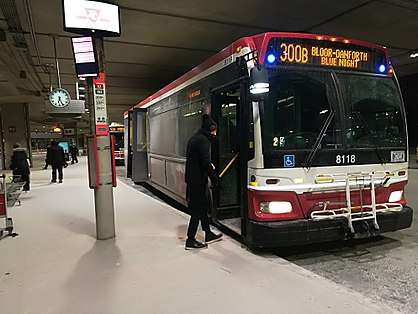
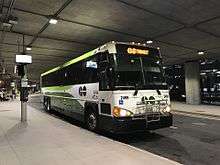
Train
- Union Pearson Express (UP Express)
The Union Pearson Express is an airport rail link running between Pearson Airport and Union Station in Downtown Toronto, with intermediate stops at Weston Station and Bloor Station.[113] Trains depart every 15 minutes from Toronto Pearson Terminal 1 station and provide a 25-minute travel time to Union Station, the busiest multimodal transportation facility in Canada.[114] The UP Express operates daily between 5:27 am and 12:57 am.[115] - Link Train
The LINK Train is an automated people mover that facilitates inter-terminal transportation at Pearson Airport. It runs between Terminal 1, Terminal 3, and the Viscount Value Park Lot, connecting to the airport terminals at Toronto Pearson Terminal 1 Station and Toronto Pearson Terminal 3 Station.[116] The LINK train operates daily, 24-hour service with trains departing all stations every 4 to 8 minutes.[117]
Bus
- Toronto Transit Commission (TTC)
The Toronto Transit Commission operates daily, 24-hour public transit bus service from Pearson Airport to the city of Toronto, with "Airport Rocket" express service to Kipling station (

- GO Transit
GO Transit operates daily, 24-hour public transit coach service from Pearson Airport to cities across the Greater Toronto Area, with express service to Richmond Hill Terminal and Hamilton GO Centre,[123] and local service to Finch Terminal.[124] GO Transit coaches arrive and depart from Terminal 1. - MiWay
MiWay operates daily, all-day public transit bus service from Pearson Airport to the city of Mississauga, with express service to City Centre Transit Terminal and Humber College,[125] and local routes to Westwood Square Terminal,[126] Renforth station,[127] Meadowvale Town Centre Terminal, and Islington station.[128] MiWay busses arrive and depart from Terminal 1, Toronto Pearson Viscount Station, and the Infield Cargo area of the airport. - Brampton Transit
Brampton Transit operates daily, all-day public transit bus service from Pearson Airport to the city of Brampton, with express service operating to Bramalea Terminal.[129] Brampton Transit busses arrive and depart from Terminal 1. - Greyhound Canada
Greyhound Canada operates daily intercity coach service from Pearson Airport to the Toronto Coach Terminal, cities across Southern Ontario, and select cities in the U.S. States of New York and Michigan.[130] Greyhound Canada coaches arrive and depart from Terminal 1.
Taxi
Taxicabs and limousines can be accessed at designated taxi stands located outside of both Terminal 1 and Terminal 3. Only official airport-licensed taxis and limousines can legally pick up passengers at Pearson,[131] and all airport-licensed taxi and limo companies use GTAA authorized flat rate fares for travel from the airport.[132][133][134]
Transportation network company services Uber and Lyft are also available at Pearson Airport. Designated rideshare pickup zones are located at both Terminal 1 and Terminal 3.[135]
Car
Toronto Pearson is directly accessible from Highway 427 and Highway 409, with Airport Road and Dixon Road providing local access to the airport.[136] There are 12,200 parking spaces available in parking garages adjacent to Terminal 1 and Terminal 3,[22] in addition to several other parking lots located in the immediate area.[137]
Car rentals are available from various major car rental agencies located in the parking garages adjacent to both terminals.[138] Car rentals are also available from off-airport car rental agencies located near Toronto Pearson Viscount Station, accessible from both terminals via the Link Train.[138]
Shuttle
Pearson is served by several out-of-town van and minibus shuttle operators which provide transportation from the airport to cities, towns, and villages throughout Southern Ontario, and to select cities and towns in the U.S. States of New York and Michigan.[139]
Proposed transit hub
In February 2017, the GTAA announced a proposed transit hub to be located across from Terminal 3 that would connect with Union Pearson Express and may connect with other transit lines extended to the airport like Line 5 Eglinton LRT and GO Transit Regional Express Rail.[140] This proposal would eliminate the Link Train connecting Terminals 1 and 3 with a bridge from the transit hub to Terminal 3 and another bridge connecting Terminal 3 to Terminal 1.[140]
Statistics
Annual traffic
| Year | Total passengers | % change | Domesticc | % change | Transborderc | % change | Internationalc | % change |
|---|---|---|---|---|---|---|---|---|
| 2017[8] | 47,130,358 | 17,475,217 | 12,855,891 | 16,799,250 | ||||
| 2016[5] | 44,335,198 | 16,906,560 | 12,054,296 | 15,374,342 | ||||
| 2015[141] | 41,036,847 | 15,859,289 | 11,154,435 | 14,023,123 | ||||
| 2014[141] | 38,571,961 | 15,192,126 | 10,506,070 | 12,874,220 | ||||
| 2013[141] | 36,107,306 | 14,385,001 | 9,838,121 | 11,884,184 | ||||
| 2012[141] | 34,911,850 | 13,646,163 | 9,464,858 | 11,800,829 | ||||
| 2011[141] | 33,435,277 | 13,078,513 | 8,979,103 | 11,377,661 | ||||
| 2010[142] | 31,936,098 | 12,730,680 | 8,628,851 | 10,576,567 | ||||
| 2009[142] | 30,368,339 | 12,730,047 | 8,074,027 | 9,564,265 | ||||
| 2008[142] | 32,334,831 | 13,812,866 | 8,805,898 | 9,716,067 | ||||
| 2007[142] | 31,446,199 | 13,744,155 | 8,879,180 | 8,822,864 | ||||
| 2006[142] | 30,794,581 | 13,309,531 | 8,906,324 | 8,578,726 | ||||
| 2005[142] | 29,914,750 | 12,906,457 | 8,803,505 | 8,204,788 | ||||
| 2004[142] | 28,615,981 | 12,636,748 | 8,422,537 | 7,556,696 | ||||
| 2003[142] | 24,739,312 | –––– | 11,021,760 | –––– | 7,316,287 | –––– | 6,401,265 | –––– |
- Notes
- ^c : At Toronto Pearson and at other airports in Canada with United States border preclearance, a distinction is made between "transborder" and "international" flights for operational and statistical purposes. A "transborder" flight is a flight between Canada and a destination in the United States, while an "international" flight is a flight between Canada and a destination that is not within the United States or Canada. A "domestic" flight is a flight within Canada only.
Incidents and accidents
- On October 3, 1959, Vickers Viscount CF-TGY of Trans-Canada Air Lines was written off when it landed short of the runway.[143] No fatalities among the 38 on board.
- On February 10, 1960, a Super Constellation of Trans-Canada Air Lines was seriously damaged when it overran the runway after landing in bad weather. None of the 59 passengers and crew were injured.[144]
- On June 13, 1964, Vickers Viscount CF-THT of Air Canada was damaged beyond economical repair when it crash-landed after the failure of two engines on approach.[145]
- The airport's deadliest accident occurred on July 5, 1970, when Air Canada Flight 621, a DC-8 jet, flew on a Montreal–Toronto–Los Angeles route. The pilots inadvertently deployed spoilers before the plane attempted landing, forcing the pilots to abort landing and takeoff. Damage to the aircraft that was caused during the failed landing attempt caused the plane to break up in the air during the go-around, killing all 100 passengers and nine crew members on board when it crashed into a field southeast of Brampton. Controversy remains over the cleanup effort following the crash, as both plane wreckage debris and human remains from the crash are still found on the site.[146]
- On August 30, 1970, Douglas C-47 CF-JRY of D G Harris Productions was damaged beyond economic repair in a storm.[147]
- On June 26, 1978, Air Canada Flight 189 to Winnipeg overran the runway during an aborted takeoff, and crashed into the Etobicoke Creek ravine. Two of the 107 passengers on board the DC-9 were killed.
- On June 22, 1983, Douglas C-47A C-GUBT of Skycraft Air Transport crashed on takeoff roll at Toronto International Airport while on an international cargo flight from Cleveland Hopkins International Airport, Ohio. Both of the crew members were killed.[148]
- On August 2, 2005, Air France Flight 358, an Airbus A340-300 (registration F-GLZQ) inbound from Paris, landed on runway 24L during a severe thunderstorm, failed to stop, and ran off of the runway into the Etobicoke Creek ravine. The rear third of the plane burst into flames, eventually engulfing the whole plane except the cockpit and wings. There were 12 serious injuries, but no fatalities. The investigation predominantly blamed pilot error when faced with the severe weather conditions.[149]
See also
- CFBN
- History of Toronto Pearson International Airport
- List of airports in the Greater Toronto Area
- YYZ (instrumental), a song named after the airport's IATA code by Canadian band Rush
References
- ↑ Canada Flight Supplement. Effective 0901Z 19 July 2018 to 0901Z 13 September 2018.
- ↑ "Synoptic/Metstat Station Information". Retrieved May 15, 2011.
- ↑ "Airport Divestiture Status Report". Tc.gc.ca. January 12, 2011. Retrieved February 19, 2011.
- ↑ "TORONTO PEARSON AIRCRAFT MOVEMENT" (PDF). torontopearson.com. Retrieved February 13, 2017.
- 1 2 "TORONTO PEARSON AIRCRAFT MOVEMENT" (PDF). June 1, 2017. Retrieved June 1, 2017.
- ↑ "About Toronto Pearson". Greater Toronto Airports Authority. Retrieved June 5, 2018.
- ↑ "Toronto Pearson Fast Facts". Airports Council International. Retrieved April 18, 2014.
- 1 2 TORONTO PEARSON (Enplaned + Deplaned ) PASSENGER 2014-2018
- 1 2 "Chapter 14: Land Use" (PDF). The Airport Master Plan (2000-2020). Greater Toronto Airports Authority. Retrieved January 26, 2012.
The Airport occupies some 1,867 ha (4,613 acres) and is adjacent to Highway 401, the main east/west highway route through southern Ontario and the busiest highway in North America. The bulk of the Airport (1,824 ha 4,507 acres) is within the City of Mississauga with 43 ha (106 acres) located within the City of Toronto.
- ↑ "Chater 6: Passenger Terminals" (PDF). Greater Toronto Airports Authority. Retrieved July 23, 2018.
Toronto Pearson now operates two main passenger terminals, Terminal 1 and Terminal 3.
- ↑ "About Air Canada - Corporate Profile". aircanada.com. Retrieved July 24, 2018.
Air Canada's four hubs, Toronto (YYZ), the primary global hub, Montreal (YUL), the gateway to French international markets, Vancouver (YVR), the airline's premier gateway to Asia Pacific, and Calgary (YYC), offer Air Canada customers smooth connections under one roof.
- ↑ "Airports in the national airports category (Appendix A)". Transport Canada. December 16, 2012. Archived from the original on June 7, 2011. Retrieved January 2, 2013.
- ↑ "Preclearance Locations - U.S. Customs and Border Protection". U.S. Department of Homeland Security. Retrieved June 1, 2018.
- ↑ "Airlines & Destinations: Canadian Destinations". torontopearson.com. Retrieved July 14, 2014.
- ↑ "TORONTO PEARSON - AIRPORT 101" (PDF). torontopearson.com.
- ↑ "Airlines and Destinations: International Destinations". Greater Toronto Airports Authority. Retrieved July 11, 2014.
- ↑ "Airlines and Destinations: US Destinations". Greater Toronto Airports Authority. Retrieved July 11, 2014.
- ↑ Cook, Dave (2010). Fading History Vol. 2. Mississauga, Ontario: David L. Cook. p. 158. ISBN 978-0-9734265-3-3.
- ↑ Dexter, Brian (March 16, 1974). "Malton residents say they've had enough". Toronto Star. p. B09.
- 1 2 3 "GTAA Master Plan" (PDF). p. 1.19.
- ↑ "About GTAA". torontopearson.com. Retrieved September 11, 2017.
- 1 2 3 4 "Toronto Pearson Master Plan 2017-2037" (PDF). Retrieved January 23, 2018.
- ↑ Harold D. Kalman. "Airport Architecture". The Canadian Encyclopedia. thecanadianencyclopedia.com. Retrieved January 2, 2013.
- ↑ Schwartz, Adele C. (December 1, 2005). "Bonus Design". Air Transport World. Silver Spring, Maryland. Archived from the original on September 17, 2013. Retrieved September 16, 2013.
- ↑ "ThyssenKrupp Airport Systems on growth track" (Press release). ThyssenKrupp. April 11, 2006. Archived from the original on July 12, 2012. Retrieved January 2, 2013.
- ↑ "Toronto Pearson International Airport – Terminal 3 - B+H Architects".
- ↑ "Sheraton takes over Swissotel, increases Metro hotels to 4". Toronto Star. October 8, 1993. p. F7. Retrieved September 22, 2010.
- 1 2 "International Departures - Toronto Pearson". GTAA. Retrieved June 26, 2018.
Passengers flying on Aer Lingus, WOW, Azores, Icelandair, Condor and Ukraine International will be boarding their aircraft at the Infield Terminal, accessed by bus that leaves from Terminal 3.
- ↑
"Toronto Pearson International Airport - Infield Development Project". Bharchitects. 2013. Archived from the original on November 14, 2013.
Located on a 470-acre [190 ha] site between four major runways, this $250 million development is Canada's largest design-build project and comprised of six structures totaling 1,356,360 square feet: the Air Canada Maintenance Building, three cargo buildings including the Air Canada Cargo Terminal, a 3-bay Hangar Facility, and the 11-gate Infield Holdroom Terminal.
- 1 2 "Toronto Pearson Master Plan - Chapter 6 : Passenger Terminals" (PDF). Archived (PDF) from the original on July 25, 2014. Retrieved July 12, 2014.
The Infield Terminal (IFT) was constructed to provide interim gating capacity during the phased construction of Terminal 1. The first two gates became operational in June 2002, with the remaining nine gates opening the following year. (The final three gates opened in July 2003, bringing the total available to 11.)
- ↑
"Air Canada opens new Maple Leaf Lounge at the Infield Terminal at Toronto Pearson Airport". Express Voyage. February 10, 2005. Archived from the original on September 17, 2014.
Air Canada will officially open its newest Maple Leaf Lounge at the Infield Terminal at Toronto Pearson Airport on February 10, 2005.
- ↑ "Lights, cameras and action at Toronto Pearson International Airport". Archived from the original on September 17, 2014. Retrieved July 12, 2014.
- 1 2 "Skyservice Toronto Airport FBO - Fixed Base Operations". Skyservice.com. Retrieved September 18, 2017.
- ↑ "Chapter 10 - Business Aviation" (PDF). GTAA.
- ↑ Barnard, Linda (September 6, 2017). "How to hide a celebrity at the Toronto International Film Festival". Retrieved September 11, 2017 – via Toronto Star.
- ↑ http://www.torontopearson.com/uploadedFiles/GTAA/Content/About_GTAA/Strategy/Master_Plan/Chapter_1.pdf
- ↑ http://www.torontopearson.com/uploadedFiles/GTAA/Content/About_GTAA/Strategy/Master_Plan/MP%20-%20Chapter%205%20-%20The%20Airside%20System.pdf
- ↑ Christopher Hume (December 14, 2012). "All Eyes on the Ground". Toronto Star. Retrieved January 3, 2013.
- ↑ "About Pearson Airport Professional Firefighters Association (PAPFFA)". PAPFFA. Retrieved June 5, 2018.
- 1 2 April 14, 2013 6:04 PM EDT Facebook Twitter RSS (November 29, 2009). "Clearing Pearson airport for takeoff in the winter". Toronto Star. Retrieved April 14, 2013.
- ↑ "Oshkosh HT-Series Chosen by Toronto International Airport | Team Eagle Ltd. ~ Your Airfield Solutions Partner". Team-eagle.ca. August 4, 2010. Retrieved April 14, 2013.
- 1 2 "Winter Operations". Greater Toronto Airports Authority. Retrieved December 10, 2013.
- ↑ Patel, Arti (February 3, 2011). "Clearing a Plane of Snow is Deicing on the Cake". The Globe and Mail.
- ↑ "Toronto Pearson International Airport - Master Plan 2017-2037" (PDF). Greater Toronto Airports Authority. Retrieved July 31, 2018.
Toronto Pearson handles about 50 per cent of the international air cargo in Canada, making our airport a critical link in the supply chain of Canadian businesses.
- ↑ "Advanced Cargo Facilities". GTAA. Retrieved January 3, 2013.
- 1 2 3 4 5 6 "GTAA Master Plan" (PDF). GTAA. Retrieved February 9, 2016.
- ↑ "Inside Pearson Airport's ultra-luxe private hub for celebs, executives and well-to-dos - Toronto Life". Archived from the original on July 3, 2015. Retrieved September 11, 2017.
- ↑ "Airport Division - Peel Regional Police". Peel Regional Police. Retrieved February 11, 2016.
- ↑ ""O" Division Greater Toronto Area (GTA) - Royal Canadian Mounted Police". Royal Canadian Mounted Police. Retrieved February 11, 2016.
- ↑ "Key Agencies - Toronto Pearson International Airport". Greater Toronto Airports Authority. Retrieved July 22, 2018.
- ↑ "TImetables". Aer Lingus.
- ↑ "TImetables". Aeroméxico.
- ↑ "Air Canada W18 Sun Destinations service changes as of 18JUN18". routesonline.com. Retrieved June 19, 2018.
- ↑ http://www.travelweek.ca/news/air-canada-adds-vienna-ex-toronto-seasonal-service-to-bordeaux-out-of-yul/
- ↑ "Air Canada expands 737 MAX 8 network in W18". routesonline.com. August 1, 2018. Retrieved August 1, 2018.
- 1 2 3 "Flight Schedules". Air Canada.
- 1 2 3 "Air Canada to drop three US cities". FlightGlobal.com. October 3, 2018. Retrieved October 3, 2018.
- ↑ "Air France flight schedule". Air France.
- ↑ "Air Transat adds Toronto - Edmonton service from Nov 2018". routesonline.com. Retrieved May 10, 2018.
- ↑ "Canadian airlines to resume service next winter to St. Maarten, Puerto Rico". ctvnews.ca. 1 May 2018. Retrieved 26 September 2018.
- ↑ "Airtransat adds Toronto – Santiago de Cuba nonstop sector in W18". RoutesOnline. August 9, 2018. Retrieved August 9, 2018.
- ↑ "Air Transat announces Direct Flights from Toronto to Split for Summer 2019". Total Croatia. Retrieved 2018-09-27.
- ↑ "Air Transat Flight status and schedules". Flight Times. Air Transat.
- ↑ "Flight schedule and operations". Alitalia.
- ↑ http://s21.q4cdn.com/616071541/files/doc_news/2018/08/American-Airlines-Expands-European-Footprint-and-Modifies-Asia-Service-GUIDE-082118.pdf
- 1 2 "Flight schedules and notifications". American Airlines.
- ↑ https://www.routesonline.com/news/38/airlineroute/280829/air-canada-austrian-adjusts-s19-canada-austria-service-/
- ↑ "Austrian Timetable". Austrian Airlines.
- ↑ "Check Itineraries". Avianca.
- ↑ "Schedules". Azores Airlines.
- ↑ "Timetables". British Airways.
- ↑ "Timetable". Brussels Airlines.
- ↑ "Timetable". Caribbean Airlines.
- ↑ "Flight Timetable". Cathay Pacific.
- ↑ "Schedules and Timetable". China Eastern Airlines.
- ↑ "Timetable". China Southern Airlines.
- ↑ "Timetable". Condor Flugdienst.
- ↑ "Flight Schedule". Copa Airlines.
- ↑ "Schedules and destinies". Cubana de Aviación.
- 1 2 "Flight Schedules". Delta Air Lines.
- ↑ "Timetable". EgyptAir.
- ↑ "Flight Schedule". El Al.
- ↑ "Flight Schedules". Emirates.
- ↑ "Schedule". Ethiopian Airlines.
- ↑ "Flight Timetables". Etihad Airways.
- ↑ "Timetables and Downlaods". EVA Air.
- ↑ The Canadian Press (August 3, 2018). "Flair Airlines is leaving Hamilton for Toronto's Pearson International Airport". thestar.com. Retrieved August 4, 2018.
- ↑ "Flair Airlines outlines US network in 4Q18". routesonline.com. August 22, 2018. Retrieved August 22, 2018.
- ↑ "Schedule". Flair Airlines. Archived from the original on March 26, 2018. Retrieved July 24, 2018.
- ↑ "Timetables". Fly Jamaica Airways.
- ↑ "Hainan Airlines adds 1-stop Chongqing – North America flights from Oct 2018". routesonline. Retrieved 18 September 2018.
- ↑ "Flight Schedule". Hainan Airlines.
- ↑ "Flight Schedule". Icelandair.
- ↑ "Flight Schedule". Interjet.
- ↑ "Download Domestic and International Flight Schedules Online". Jet Airways.
- ↑ "View the Timetable". KLM.
- ↑ "Flight Status and Schedules". Korean Air.
- ↑ "Timetables". LOT Polish Airlines.
- ↑ "Timetable - Lufthansa Canada". Lufthansa.
- ↑ "PIA - Weekly Flight Schedule". Pakistan International Airlines.
- ↑ "Flight Timetable". Philippine Airlines.
- ↑ "Saint Maarten and Saint Martin: One Year After Irma". travelpulse.com. 7 September 2018. Retrieved 26 September 2018.
- ↑ "CAPA - Sunwing".
- ↑ "Our Routes" (PDF). Sunwing Airlines.
- ↑ "All Destinations". TAP Portugal.
- ↑ "Online Flight Schedule". Turkish Airlines.
- ↑ "Online Flight Schedule". UIA.
- 1 2 "United Flight Schedules". United Airlines.
- ↑ CBC News (August 24, 2018). "WestJet's Fort McMurray to Toronto route cancellation 'disappointing'". Retrieved August 27, 2018.
- 1 2 "Flight Schedules - when we fly". Westjet.
- ↑ https://www.sudbury.com/local-news/westjet-ending-flights-out-of-sudbury-in-october-974258
- ↑ "Route Map". WOW air.
- ↑ "UP Express". GTAA.
- ↑ "Union Station - City of Toronto". City of Toronto. Retrieved August 9, 2018.
- ↑ "Union Pearson Express". Metrolinx.
- ↑
Irwin Rapoport (July 6, 2006). "Airport opens automated people mover: New train system connects three terminals, parking area". Toronto: Daily Commercial News. Archived from the original on February 12, 2013. Retrieved February 12, 2013.
It's a 1.5-kilometre train with three stations gliding along an elevated guideway connecting Terminals 1, 3 and a reduced rate parking area serving both passengers and employees of the Greater Toronto Airports Authority (GTAA).
- ↑ "Terminal Link". Toronto Pearson. Retrieved January 5, 2016.
- ↑ "192 Airport Rocket". Toronto Transit Commission (TTC). Retrieved August 13, 2018.
- ↑ "52 Lawrence West". Toronto Transit Commission (TTC). Retrieved August 13, 2018.
- ↑ "300 Bloor–Danforth". Toronto Transit Commission (TTC). Retrieved August 13, 2018.
- ↑ "332 Eglinton West". Toronto Transit Commission (TTC). Retrieved August 13, 2018.
- ↑ "352 Lawrence West". Toronto Transit Commission (TTC). Retrieved August 13, 2018.
- ↑ "40 Hamilton/ Richmond Hill GO Bus Schedule" (PDF). GO Transit. Retrieved August 13, 2018.
- ↑ "34 Pearson Airport/ North York GO Bus Schedule" (PDF). GO Transit. Retrieved August 13, 2018.
- ↑ "MiExpress 107 Malton Express" (PDF). Mississauga.ca. Retrieved August 13, 2018.
- ↑ "MiLocal 7 Airport" (PDF). Mississauga.ca. Retrieved August 13, 2018.
- ↑ "MiLocal 24 Northwest" (PDF). Mississauga.ca. Retrieved August 13, 2018.
- ↑ "MiLocal 57 Courtneypark" (PDF). Mississauga.ca. Retrieved August 13, 2018.
- ↑ "115 Bramalea Terminal–Bramalea Road–Pearson Airport" (PDF). Brampton Transit. Retrieved August 13, 2018.
- ↑ "Greyhound Adds Stop At Toronto Pearson International Airport". CNW Newswire.ca. April 20, 2017. Retrieved April 26, 2017.
- ↑ "Taxis & Limousines". GTAA.com. Retrieved August 13, 2018.
- ↑ "Taxi Tarrifs from Toronto Pearson" (PDF). GTAA.com. March 1, 2018. Retrieved August 10, 2018.
- ↑ "Limo Tarrifs from Toronto Pearson" (PDF). GTAA.com. March 1, 2018. Retrieved August 10, 2018.
- ↑ "Out of Town Tarrifs from Toronto Pearson" (PDF). GTAA.com. March 1, 2018. Retrieved August 10, 2018.
- ↑ "Directions: From South-QEW". GTAA.com. Retrieved January 3, 2013.
- ↑ "Parking". torontopearson.com. Retrieved August 13, 2018.
- 1 2 "Car Rentals". GTAA.com. Retrieved March 6, 2016.
- ↑ "Out-of-Town Van Services". Gtaa.com. January 3, 2013. Retrieved January 3, 2013.
- 1 2 "GTAA Unveils Vision For Multi-Modal Transit Hub at Pearson - Urban Toronto". urbantoronto.ca. Retrieved September 11, 2017.
- 1 2 3 4 5 ,TORONTO PEARSON (Enplaned + Deplaned ) PASSENGER 2011-2015
- 1 2 3 4 5 6 7 8 "TORONTO PEARSON (Enplaned + Deplaned ) PASSENGER 2003-2013" (PDF). Retrieved September 11, 2017.
- ↑ "Accident description". Aviation Safety Network. Retrieved January 3, 2013.
- ↑ "Skids Off Runway on Belly: 59 Safe in Crackup at Malton As Airliner Overshoots in Fog: TCA Plane Crashes Into Fence". Globe and Mail. Toronto. 1960-02-11. p. 1.
- ↑ "Accident description". Aviation Safety Network. Retrieved October 6, 2009.
- ↑ Wilkes, Jim (July 6, 2004). "Ghosts of Flight 621 haunt Brampton field". Toronto Star. p. A1. Retrieved January 3, 2013.
- ↑ "CF-JRY Hull-loss description". Aviation Safety Network. Retrieved October 20, 2010.
- ↑ "C-GUBT Accident report". Aviation Safety Network. Retrieved July 27, 2010.
- ↑ "Aviation Investigation Report - Runway Overrun and Fire - Air France Airbus 340-313 F-GLZQ - Toronto/Lester B. Pearson International Airport, Ontario - 02 August 2005 - Report Number A05H0002". Transportation Safety Board of Canada. 2007. ISBN 978-0-662-47298-8. Public Works and Government Services Canada Cat. No. TU3-5/05-3E. Retrieved December 13, 2007. [Aussi disponible en français: "Rapport d'enquête aéronautique A05H0002"
External links
| Wikimedia Commons has media related to Toronto Pearson International Airport. |
| Wikivoyage has a travel guide for Toronto Pearson International Airport. |
- Past three hours METARs, SPECI and current TAFs for Toronto Pearson International Airport from Nav Canada as available.